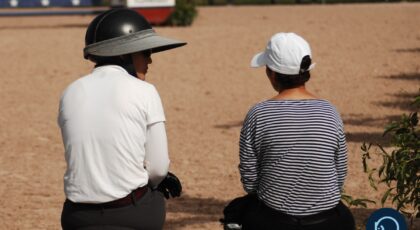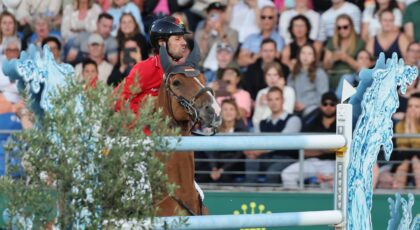Do you think of yourself as an equestrian? Do you think of yourself as an equestrian athlete? If you aren’t accustomed to including the word athlete in your Instagram profile, you’re missing an important component to becoming a successful rider. Your fitness is just as important to your performance as your horse’s. Yes, you are an athlete, too.

Photo by Cindy Lawler
But getting fit to ride doesn’t have to mean sweating it out in the gym or spending more time away from the barn rather than in it. Coach Daniel Stewart believes in using the time and space around you to become the best equestrian athlete you can be, and in his book Fit & Focused in 52, he provides a physical exercise, along with a mental focus tip, for every week of the new year.
For this exercise you’re going to using your arena and jump poles for much more than riding. Your arena is going to become your gym and the jump poles are going to become your exercise equipment. Not only will you be jumping, you’ll be traveling a bit, too. Trot Pole Squats improve your:
– Stamina
– Balance
– Coordination
– Body Awareness
– Symmetry
– Rhythm
They strengthen and condition the following muscle groups:
– Hip Flexors/Extensors
– Quadriceps
– Hamstrings
– Lower Leg
Here’s how you’re going to do Trot Pole Squats:
1. Start in the BASE standing in front of four (or more) jump poles. The BASE is the Basic Athletic Stance of Equestrians. So just what does the basic athletic stance look like? Well, the first thing you need to do is identify the natural position of your riding discipline. For example, the position of the dressage rider would be characterized by shoulders open, upper body on (or near the vertical), and long legs with slightly bent knees. Conversely, the position of the jumper rider would be characterized by an upper body that’s slightly in front of the vertical with the knees more bent.

Photo by Marc Minisci
2. Lower yourself by bending your knees (feel the quads burn). Remember to keep your back flat, core tight, eyes up, and shoulders open.
3. Extend your knees to begin the jumping phase of the exercise.
4. Continue extending your knees so your feet leave the ground.

Photo by Marc Minisci
5. Maintain good form and balance in the air.
6. Land equally on the other side of the pole in your BASE.
7. Bend your knees to absorb the shock and get ready to do it again!

Photo by Marc Minisci
Size Is Important
Place each pole about 2 feet apart. When the exercise becomes too easy, go ahead and spread them out a bit more.
Not Hard Enough?
If you’d like a little additional challenge, replace the jump poles with small cross rails (set in the bottom hole of the jump standard). Now you’re going to need to create more energy to just jump the poles without knocking them over.
***
This excerpt from Fit & Focused in 52 by Coach Daniel Stewart is reprinted with permission from Trafalgar Square Books


 January 10, 2018
January 10, 2018 


























